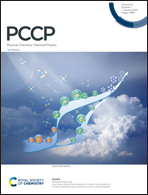Character of intermolecular vibrations in the benzene–neon complex based on CCSD(T) and SAPT potential energy surfaces†
Abstract
The intermolecular potential energy surface of the benzene–neon complex is constructed using highly accurate electronic structure methods for the ground electronic state. The interaction energies have been calculated with the CCSD(T) (coupled cluster level including single and double excitations supplemented by triple excitation) method and symmetry-adapted perturbation theory based on the density functional and CCSD descriptions of monomer properties (DFT-SAPT and CCSD-SAPT) with augmented triple Dunning's basis set (aug-cc-pVTZ) supplemented by the midbond functions. The analytical PESs have been constructed using an analytical long-range part based on spherical multipole expansion and a short-range part based on many-body expansion. The potential is characterized by two symmetrically equivalent global minima located at the benzene C6 axis of symmetry and by local minima lying in the benzene plane on the axes connecting the benzene center of mass and the middle of CC bonds. The values of the equilibrium geometry parameters, the dissociation energy and vibrational energy have been extracted from these potentials and compared to their empirical counterparts derived previously from the microwave spectra. The complex is characterized by large-amplitude motion of the Ne atom which, however, can be studied with a theoretical approach with neglected tunneling motion through the monomer plane, when the lowest vibrational energy levels are considered.



 Please wait while we load your content...
Please wait while we load your content...